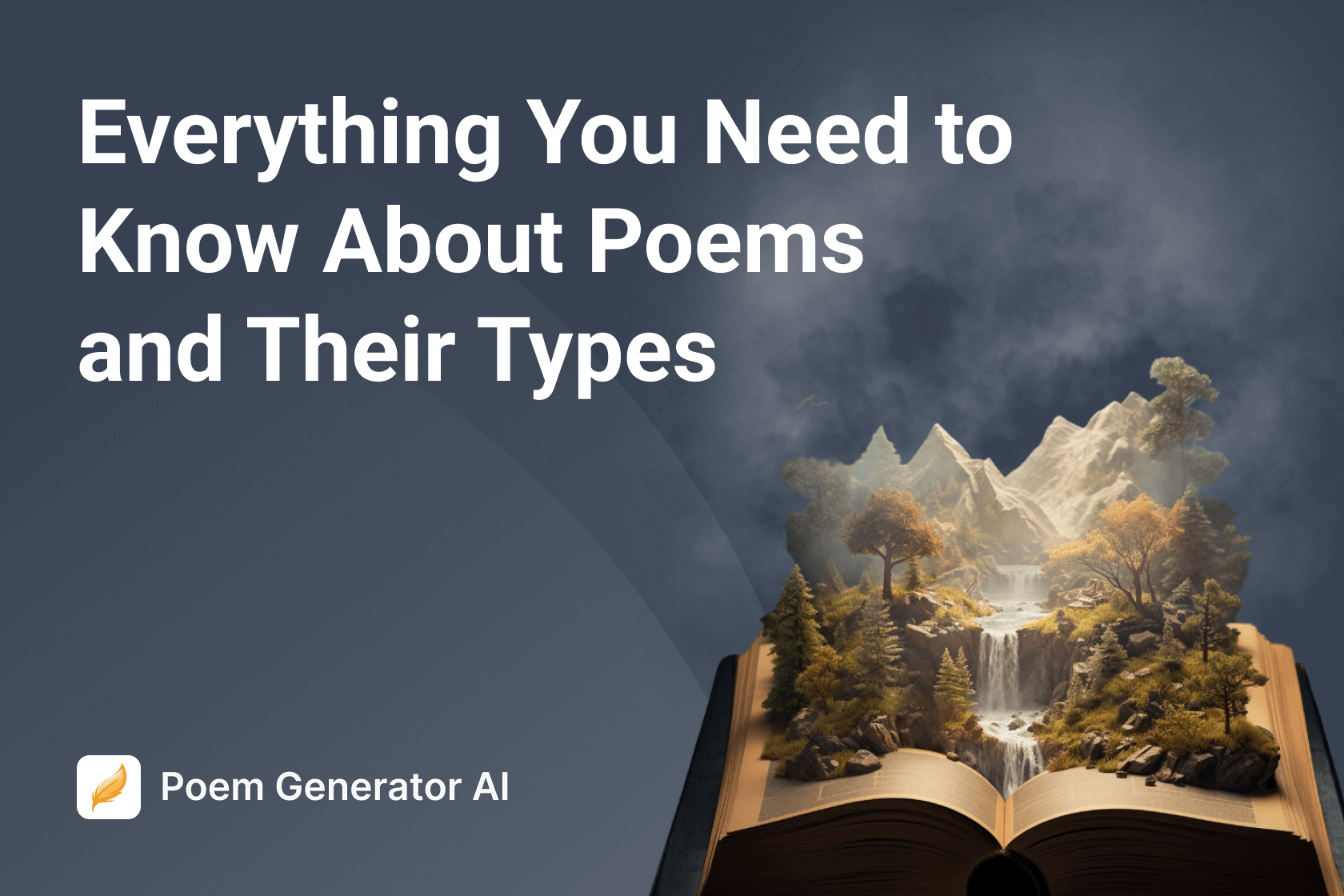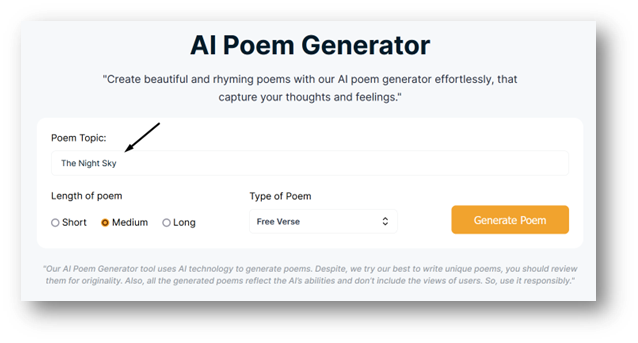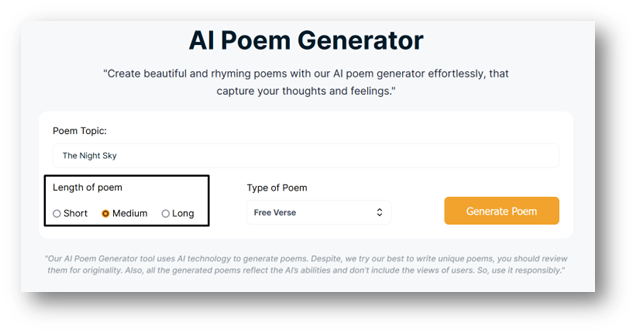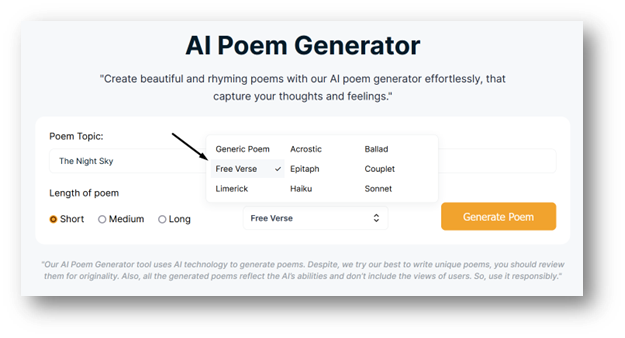

Poetry is one of the most powerful forms of expression. It allows writers to capture emotions, tell stories, and deeply explore human understanding through carefully chosen words and structured language.
Unlike other forms of literature, poetry uses meter, rhyme, and rhythm to create a unique and aesthetic reading experience. Maybe this is why crafting a great poem that can get the readers hooked is so hard. This is where AI tools like our AI Poem Generator can come in handy.
It provides inspiration and assistance in various forms of poetic compositions. Having said that, we will delve into discussing all about different types of poems and show you how our tool can help you write them. But before we get into all that, let us briefly explain what exactly a poem is for those who are unfamiliar with the concept.
A poem is a form of literature in which a writer usually expresses their feelings and ideas. These things are given intensity by the use of distinct style and rhythm.
In poems, language is used carefully, every word is chosen to evoke emotions, create imagery, and convey a deeper meaning. Additionally, poetry can be as short as a couple of lines or can consist of multiple pages. It can also adhere to strict rules or embrace free expression.
There are quite a few types of poems out there. However, some of the most commonly recognized ones are:
We will now explore each of these types below.
The Poem Generator that we offer is capable of crafting Free Verse, Limerick, Acrostic, and all the other poem types that we’ve mentioned above in an instant. It uses artificial intelligence to understand the topic provided by users and generate an accurate, compelling, and rhyming poem around it.
Having said that, the following are the steps that you have to follow to generate poems using our tool.



Once all this is done, click on the “Generate Poem” button and wait for the output. After a couple of seconds, the tool will display the generated poem.
This is how easy it is to craft poems using our poem generator tool. Much of your time can be saved and the process of brainstorming and coming up with ideas can be skipped completely.
A free verse poem is one of the most liberating forms of poetry. This is because, unlike traditional forms, free verse does not follow a specific rhyme scheme, meter, and structure.
This allows the poet to write however they like. They can write in a way that mimics speech rather than a poem. The length is also not an issue here as free verses can be as long as the poet wants and the grammar structures are continuously repeated.
Basically, there are no formal rules that have to be followed in free verse.
As mentioned, free verse doesn’t exactly follow a strict structure. However, it often relies on line breaks, punctuation, and the arrangement of words so the poem can at least make some sense to the reader.
Additionally, the structure in free verse is determined by the poet’s intention, whatever they want can be achieved.
While free verse lacks the general rules of a traditional poem, some guiding principles are as follows:
Use of Imagery: Using strong and vivid imagery in the poem can enhance the reader's experience. They can better understand what the poem is about.
Line Breaks and Punctuation: The poem’s pacing and flow can be influenced using these elements. If they are used right, the poetry becomes more interesting.
Repetition: Repeating words, phrases, and ideas can add emphasis and cohesion to the poem.
A limerick is often a light-hearted, humorous poem consisting of five lines in total. It follows a specific rhyme scheme (AABBA) and has a unique rhythm that makes it easy to remember, fun, and exciting.
Additionally, a limerick poem is commonly associated with wit and playfulness. They can’t be used to talk about serious stuff like the passing of a loved one.
This type of poem usually has to follow the structure mentioned below.
Lines 1 and 2: These lines include setting a scene or introducing a character while following an 8-syllable pattern. It then ends with a rhyming word.
Lines 3 and 4: Shorter lines than 1 and 2. They usually have 5-6 syllables and rhyme with each other.
Line 5: Here, the 8-syllable pattern has to be followed again. It rhymes with the first two lines and often provides a humorous and unexpected conclusion.
While crafting a limerick poem, the following rules have to be followed.
Rhyme Scheme: AABBA.
Syllable Count: Typically, 8-8-5-5-8, but slight variations in lines 3 and 4 are common.
Tone: Generally humorous, with a twist or punchline at the end.
An acrostic poem is one in which the first, last, or other letters in each line spell out a word, name, or phrase when read vertically. The word or message is often related to the theme of the poem. It often adds an extra layer of meaning to the context.
Additionally, it is worth mentioning that the most common and simple form of an acrostic poem is when the first letter of each line spells something out.
These poems are usually taught to children during primary school. Their main purpose is fun and casual use rather than serious and high-level academic settings.
A great acrostic poem usually has the following structure.
Vertical Word or Name: The first letters of each line of the poem should form a word when spelled vertically. Careful consideration is required here.
No Rhyme or Meter: Acrostic poems don’t need a rhyme scheme or follow a specific meter. However, if the poet wants it, they can add these elements even though they are not needed.
There are two main rules that you should follow while writing an acrostic poem.
Word Choice: The word or phrase spelled out should be central to the poem’s theme.
Line Relevance: Each line should connect to the overall theme or the word being spelled.
An epitaph is a short poem that is written in memory of someone who has passed away. Epitaphs are also engraved on tombstones as a gesture of love. They are somber and reflective, capturing the essence of the person being remembered in a few touching lines.
Additionally, since the poem is for celebrating the memory of the deceased, it usually has a serious tone rather than humorous or witty.
The following are some of the structural elements of an epitaph poem.
Concise and Reflective: Epitaph poems are usually short. 2-4 lines are common, anything longer than that doesn’t work.
Occasional Rhyming: These poems often rhyme but not always. This is because when memorializing someone, rhyming isn’t that important.
Respectful Tone: The tone is usually respectful and reverent. Mainly because the focus is on the virtues or legacy of the deceased.
Epitaph poems have to be written while following the rules mentioned below.
Simplicity: Keep the language simple and direct.
Meaningful Content: Focus on what made the person special or how they should be remembered.
Emotion: Convey the appropriate emotions, whether it be sorrow, respect, or even a celebration of life.
A haiku is a traditional Japanese form of poetry that captures a moment in time or a scene from nature in just three lines. This type of poem is known for its simplicity, focus on nature, and the contrast between two different things.
The lines in haiku are often unrhymed and look quite casual. It can have a formal or friendly tone throughout it but not humorous. Additionally, the whole poem consists of just a few words. It’s not like the three lines are too long.
A traditional haiku follows the following structure.
Three Lines: The poem consists of three lines with a specific syllable pattern.
5-7-5 Syllable Pattern: Haikus have 5 syllables in the first line, 7 syllables in the second line, and 5 syllables in the third line.
Seasonal Reference: They can include a word that indicates the season (kigo). However, this is not necessary.
To write a good haiku, you have to consider following the below-mentioned rules.
Conciseness: Haikus are concise. They require careful word choice to convey the desired meaning effectively.
Nature Focus: Traditional haikus focus on nature, capturing a fleeting moment or image.
Contrast: More often than not, there is a contrast or shift between the first two lines and the third.
Ballad poems follow a narrative and tell a story in a musical or rhythmic manner. Ballads usually consist of quatrains (four-line stanzas) and may seem like they’re lyrics for a song.
They have a rhyme scheme ABAB or AABB. Folklores, legends, and historical events are often recounted using ballad poems. It is also worth noting that ballads are one of the oldest forms of narratives out there. They are older than any other form of written story since they are usually passed down from generation to generation.
A ballad typically has the following structure that makes it distinct from all the other types of poems.
Quatrains: Each stanza of the poem consists of four lines that rhyme with each other. These lines are relevant to the theme of the poem.
Rhyme Scheme: The rhyme scheme in a typical ballad is kept ABAB where the first line of a stanza rhymes with the third and the second line rhymes with the fourth. AABB rhyme scheme may also be followed depending on the poet’s preference.
Repetition: In ballads, repeating lines are common. This adds to the musical quality of the poem.
When writing a ballad, the following rules have to be considered.
Narrative Focus: Ballads tell a story, so clearly focusing on the narrative and its development is important.
Simple Language: The language is often straightforward, making the story easy to follow. There is no room for complex language in ballads.
Refrain: A repeated line or stanza, often called a refrain has to be added to the poem as it helps emphasize key points and maintains rhythm.
As the name suggests, a couplet is a poem that consists of only two lines. They typically have the same meter and rhyme with each other.
Since two lines aren’t enough to describe something or tell a story, couplets are often used to conclude a sonnet or other forms of poetry. They provide a sense of closure and emphasis.
A couplet usually has a simple structure, mainly because it is so short. But still, some general pointers on its structure are as follows.
Two Lines: A couplet consists of only two lines. Anything longer than that won’t be considered a couplet.
Rhyme Scheme: The lines usually rhyme with each other. They follow an AA rhyme scheme.
Meter: Couplet lines have the same meter. However, this can vary depending on the preference of the poet.
The following rules have to be followed when writing a couplet.
Clarity and Precision: Couplet poems have to have precise language to convey the intended meaning. This improves their brevity.
Closure: These poems often serve as a concluding statement to another poem or emphasize a key idea. So they should be able to provide closure or highlight a point.
A sonnet is a 14-line poem that follows a specific rhyme scheme and structure that is not exactly defined well. This is because there are two main types of sonnets: The Shakespearean (or English) sonnet and the Petrarchan (or Italian) sonnet. Each of them has a different rhyme scheme.
That being said, sonnets are typically associated with love and other deep emotions. These poems explore a single theme or idea throughout them.
This type of poem usually follows a distinct structure that we’ll mention below.
14 Lines: All sonnets have 14 lines. No more and no less.
Rhyme Scheme: The Shakespearean sonnet follows an ABABCDCDEFEFGG rhyme scheme, while the Petrarchan sonnet follows ABBAABBACDCDCD.
Iambic Pentameter: Each line typically consists of ten syllables, following an iambic pentameter rhythm (unstressed syllable followed by a stressed syllable).
When writing a sonnet, some of the rules that are usually followed by poets are as follows.
Theme: Sonnets usually have to explore themes of love, beauty, politics, mortality, or nature.
Volta: A “Volta” or turn in the poem has to be included. Here, the theme or argument shifts. This typically occurs at the ninth line in a Petrarchan sonnet or the final couplet in a Shakespearean sonnet.
Closure: The final couplet or lines have to provide a resolution to the poem or bring it to a close in a good manner.
A diamante poem is a seven-line, diamond-shaped poem that begins with one subject and ends with its opposite.
It’s a visual form of poetry that contrasts two different ideas. It is both visually appealing and intellectually stimulating. Such poems are usually taught in schools to children so they can learn how to rhyme.
Such poems have one of the most unique structures out there. They follow the approach mentioned below.
Line 1: Includes one noun that can be seen as the starting subject.
Line 2: It consists of two adjectives describing the subject.
Line 3: Three verbs ending in -ing that are related to the starting subject are added here.
Line 4: It has four nouns. The first two are related to the starting subject and the last two are related to the ending subject.
Line 5: Three verbs ending in -ing related to the ending subject.
Line 6: Two adjectives describing the ending subject.
Line 7: One noun which is the ending subject.
The following rules have to be kept in mind while writing a diamante poem.
Shape: The poem has to be written in a diamond shape, with the longest line in the middle (line 4).
Opposites: Diamante poem contrasts two opposite ideas. It has to start with one subject and end with its opposite.
Brevity: Each line has to be concise. It should use single words or short phrases to convey meaning.
Poetry is a powerful form of expression that uses carefully chosen words and structured language to convey emotions and stories.
Crafting a great poem can be challenging, but an AI tool like our AI Poem Generator can be helpful in providing inspiration and assistance in various forms of poetic compositions.
Different types of poems, such as free verse, limericks, acrostics, epitaphs, haikus, ballads, couplets, sonnets, and diamantes, each have their own unique structures and rules to follow.
Utilizing the AI Poem Generator, you can easily create poems in these various forms by inputting your chosen topic and selecting the desired type of poem. Whether it's capturing the beauty of nature in a haiku or exploring contrasting ideas in a diamante, our AI Poem Generator can assist writers in crafting creative and engaging poems effortlessly.